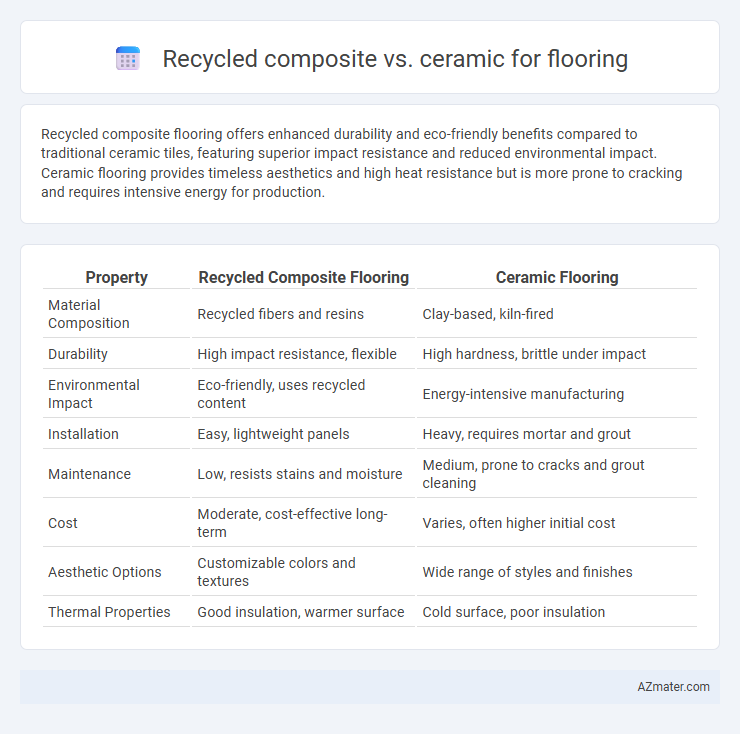Recycled composite flooring offers enhanced durability and eco-friendly benefits compared to traditional ceramic tiles, featuring superior impact resistance and reduced environmental impact. Ceramic flooring provides timeless aesthetics and high heat resistance but is more prone to cracking and requires intensive energy for production.
Table of Comparison
| Property | Recycled Composite Flooring | Ceramic Flooring |
|---|---|---|
| Material Composition | Recycled fibers and resins | Clay-based, kiln-fired |
| Durability | High impact resistance, flexible | High hardness, brittle under impact |
| Environmental Impact | Eco-friendly, uses recycled content | Energy-intensive manufacturing |
| Installation | Easy, lightweight panels | Heavy, requires mortar and grout |
| Maintenance | Low, resists stains and moisture | Medium, prone to cracks and grout cleaning |
| Cost | Moderate, cost-effective long-term | Varies, often higher initial cost |
| Aesthetic Options | Customizable colors and textures | Wide range of styles and finishes |
| Thermal Properties | Good insulation, warmer surface | Cold surface, poor insulation |
Introduction to Flooring Materials: Recycled Composite vs Ceramic
Recycled composite flooring offers enhanced durability and eco-friendly benefits by utilizing reclaimed materials such as wood fibers and plastics, making it a sustainable choice. Ceramic flooring, composed of natural clay and minerals fired at high temperatures, provides excellent moisture resistance and a wide range of design options with high hardness and low porosity. Both materials serve distinct needs: recycled composites excel in impact resistance and environmental sustainability, while ceramic tiles deliver superior longevity and ease of maintenance in high-traffic or wet areas.
Material Composition and Manufacturing Processes
Recycled composite flooring consists of a blend of reclaimed plastics and wood fibers, engineered through processes like extrusion or compression molding to enhance durability and environmental sustainability. Ceramic flooring is made from natural clay materials shaped and subjected to high-temperature kiln firing, resulting in hard, moisture-resistant tiles with a dense crystalline structure. The manufacturing of recycled composites emphasizes eco-friendly material recovery and energy-efficient production, whereas ceramic flooring relies on mining raw materials and energy-intensive firing methods to achieve its final form.
Durability and Life Expectancy Comparison
Recycled composite flooring offers superior durability with resistance to moisture, scratches, and UV exposure, making it ideal for high-traffic areas with a life expectancy of 25 to 30 years. Ceramic flooring is highly durable against wear and chemical stains, with a typically longer lifespan of 50 years or more, but it can be prone to cracking under heavy impact. Both materials require minimal maintenance, yet ceramic's higher hardness makes it suitable for long-term use in residential and commercial settings where longevity is prioritized.
Environmental Impact and Sustainability
Recycled composite flooring significantly reduces environmental impact by repurposing waste materials, lowering landfill contributions, and minimizing resource extraction compared to ceramic tiles, which require energy-intensive manufacturing and raw material mining. Composite flooring often incorporates post-consumer plastics and wood fibers, enhancing sustainability through circular economy principles and reducing carbon footprint throughout its life cycle. Ceramic flooring, while durable, generates higher greenhouse gas emissions during production and is less recyclable, making recycled composites a more eco-friendly choice for sustainable building projects.
Design Flexibility and Aesthetic Options
Recycled composites offer exceptional design flexibility due to their ability to be molded into various shapes, colors, and textures, enabling customized flooring that suits modern and sustainable aesthetics. Ceramic flooring, while limited to rigid shapes and traditional color palettes, provides a timeless, glossy finish with intricate pattern possibilities through tile arrangements. Both materials cater to diverse aesthetic preferences, but recycled composites excel in delivering innovative, eco-friendly designs with a wide range of customization.
Installation Process and Ease of Use
Recycled composite flooring offers a streamlined installation process due to its lightweight panels and click-lock system, reducing labor time and complexity compared to ceramic tiles, which require precise mortar application and grout setting. The composite's flexibility and uniform size enable easier handling and cutting on-site, enhancing user convenience and minimizing installation errors. Ceramic flooring demands specialized tools and skilled installers for a durable finish, while recycled composites provide a more user-friendly, less labor-intensive solution without compromising durability.
Maintenance Requirements and Long-Term Care
Recycled composite flooring requires minimal maintenance, involving simple cleaning with soap and water, and is resistant to staining, fading, and moisture damage, making it ideal for high-traffic areas. Ceramic flooring demands more frequent upkeep, including regular grout cleaning and periodic resealing to prevent moisture infiltration and maintain its durability. Over time, recycled composite retains its appearance with less effort, while ceramic may require more intensive care to address potential cracks or grout deterioration.
Cost Analysis: Initial Investment and Lifetime Value
Recycled composite flooring offers a lower initial investment compared to ceramic tiles, with costs ranging from $4 to $8 per square foot versus $5 to $15 for ceramic. While recycled composites provide moderate durability and resistance to impact and moisture, ceramic excels in lifespan, often lasting 25 to 40 years with proper maintenance. Evaluating lifetime value, recycled composite's lower upfront cost can be offset by more frequent replacements, whereas ceramic's higher upfront cost is balanced by its extensive durability and minimal maintenance expenses.
Performance in High-Traffic and Moisture-Prone Areas
Recycled composite flooring offers superior durability and resistance to moisture, making it ideal for high-traffic and moisture-prone areas due to its non-porous surface and flexibility. Ceramic flooring provides excellent hardness and scratch resistance but may suffer from cracking and moisture seepage in areas with heavy impact or fluctuating humidity. Both materials excel in different performance aspects; however, recycled composites outperform ceramics in resilience and moisture handling under demanding conditions.
Suitability and Recommendations for Different Applications
Recycled composite flooring offers excellent durability and moisture resistance, making it ideal for outdoor patios, high-traffic areas, and spaces prone to humidity. Ceramic flooring provides superior hardness, heat resistance, and easy maintenance, which suits kitchens, bathrooms, and commercial environments demanding hygiene and wear resistance. For eco-friendly projects, recycled composites are preferred, while ceramic is recommended for applications requiring longevity and aesthetic versatility.

Infographic: Recycled composite vs Ceramic for Flooring
 azmater.com
azmater.com